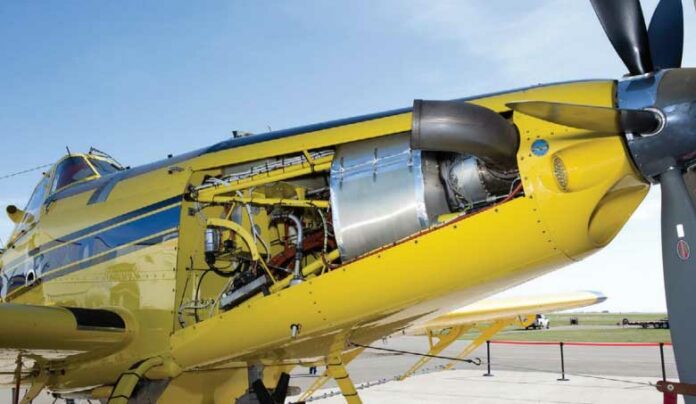When operating PT6 turbines, scheduled maintenance is regarded as being the key to flawless operations. Sometimes the compressor wash procedure is postponed as some mechanics do not fully understand its importance. Ossie Fernandez, General Manager of United Turbine, explains why it’s a very bad idea!
“When you have been in turbine business for a long time, there are some messages sent out by the manufacturer that stay with you for life! And this one comes from Pratt & Whitney Canada, regarding its PT6”.
CLEAN ENGINES RUN BETTER
It’s amazing what you can accomplish with a little soap and water. Washing your engine has a host of benefits: it improves compressor efficiency, enhances internal turbine temperature margins, lowers fuel consumption, increases the lifespan of hot section parts and reduces corrosion. These benefits improve your engine’s performance and lifecycle, extending the time between overhauls. How often you schedule engine washes depends on your specific fleet and operating conditions, but make sure you perform them regularly to keep your engine performing at its peak.

“When humans breathe contaminated air, the lungs become irritated, microscopic and macroscopic particles enter through the trachea. Natural defense mechanisms then come into play to safeguard our respiratory system. Phlegm is produced to coat these particles and the cough mechanism expels everything, allowing the lungs to return to a normal state after a while. Turbines are not completely dissimilar from our lungs. They absorb an enormous amount of air that travels directly to the blades of the compressor stage and there is no natural mechanism to clean or protect this part of the engine from very small particles that may adhere to the compressor assembly. If the air is contaminated, we will rapidly see evidence of foreign substances reaching the compressor. As the compressor is a precisely balanced part, residue sticking to the blades can lead to increased gas temperatures, blade imbalance (in extreme cases), or non-conforming acceleration rates. Furthermore, if you are operating a PT6 in maritime or very humid climate, salt will increase dramatically the chances of encountering corrosion or sulphidation on the compressor blades. It is crucial to keep the compressor disc clean and perform compressor washes at regular intervals. This helps to keep the engine performing properly, fuel flow within prescribed range, and temperatures in check.”
Do you mean that residues on the compressor are enough to cause poor performance in a PT6?
“Not the only cause, but it is one of greatest contributing factors. Some mechanics actually frown on compressor washes, convinced that they cause harm to the engine. Legends are told because they have heard of deposits in the gas generator case. These are usually caused by a poorly performed performance recovery wash, and that is a very different operation! And, frankly, chances are that soap deposits while looking horrible, will not influence engine longevity or performance. But these legends lead some mechanics to cease doing any form of compressor wash. We strongly encourage operators to perform a compressor wash any time it is needed!
And when is-it needed?
“Obviously, the first thing to do is to refer to the manufacturer’s instructions. But there are signs that should alert maintenance personnel, operators and pilots. If you have to do a FOD inspection and that the compressor looks dirty, a compressor wash should rid you of the dirt and grime. While operating the engine, if you see high gas generator speed with high T5 temps, it is time to clean out the compressor. If the compressor wash is completed and the condition persists, it might be a good idea to check the cold section for abnormal condition or damage. There is one case where we recommend a compressor rinse daily: that is if you are operating on floats or in a maritime environment. In this case a daily rinse is a good measure to preserve engine longevity and avoid corrosion. In this case, do not use soap, but just clear water.”

it is an essential accessory to maintain your turbine healthy and performance
at its peak.
We don’t see a compressor wash ring installed on our engine. This is why we don’t perform compressor washes.
“Although it is more practical to have this wash ring installed, nothing prevents the operator from referring to the engine maintenance manual. It usually includes instructions to manufacture a hand-held wash ring. At next overhaul or major maintenance, it should be possible to permanently install a wash ring. We regularly source these parts for our customers. In all cases, read carefully the maintenance manual and other technical publications to make sure these procedures are done correctly and don’t cause any ill effects to your engine.”
Do you have any insight in the type of chemicals/soap that should be used?
The first thing to do is to check your water supply. Although supposed to be potable, not all waters are suitable to inject in your engine. You can use a water testing kit originally used for dishwashers or laundry washers. You will know instantly if your water is “harsh” or “soft”. We recommend that you take all precautions to avoid water that would contain too much minerals or impurities. The easy solution is to use exclusively distilled water. The soap used should be listed in the manufacturer’s publications and approved for your type of engine. We have seen a few cases where dishwasher soap was used. The engine was not impressed and exhibited a few signs of mechanical unhappiness!
Apart from the wash ring, what hardware is necessary to perform a compressor wash?
“The hardware is pretty basic and is found around most mechanics tools chest. You will need a pressurizable liquid container, an air compressor and the necessary hoses and fittings. The cleaning solution (soap) is mixed with the water in the container (usually containing around a gallon of water), then the air compressor is connected, and the cleaning solution is pressurized (around 35 Psi). When the engine is turning (no fuel injection, no ignitors), the container is allowed to send the water to the washing ring. It is dispersed evenly on the compressor and cleans the blades. A good rinse, and the job is done.





